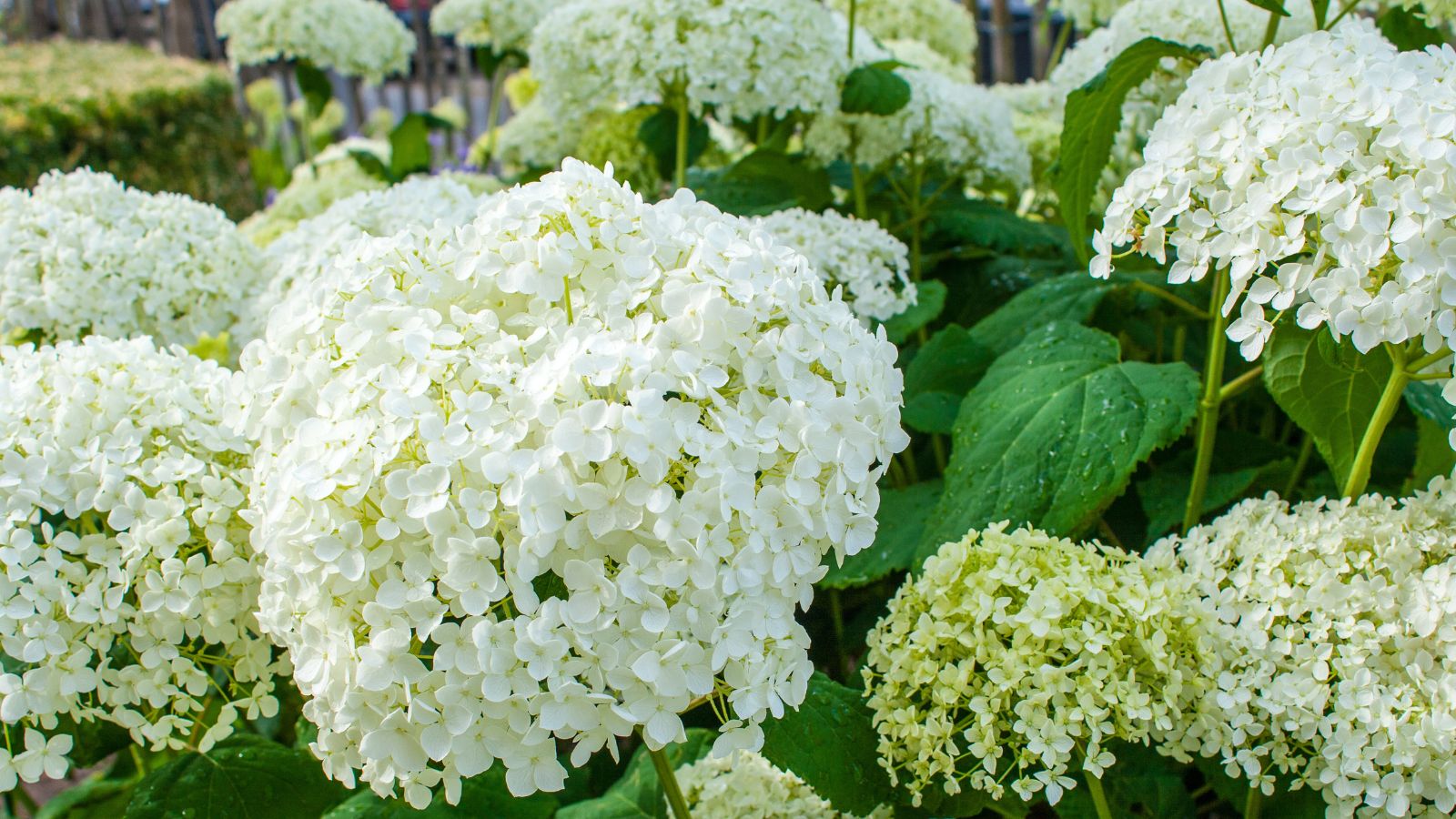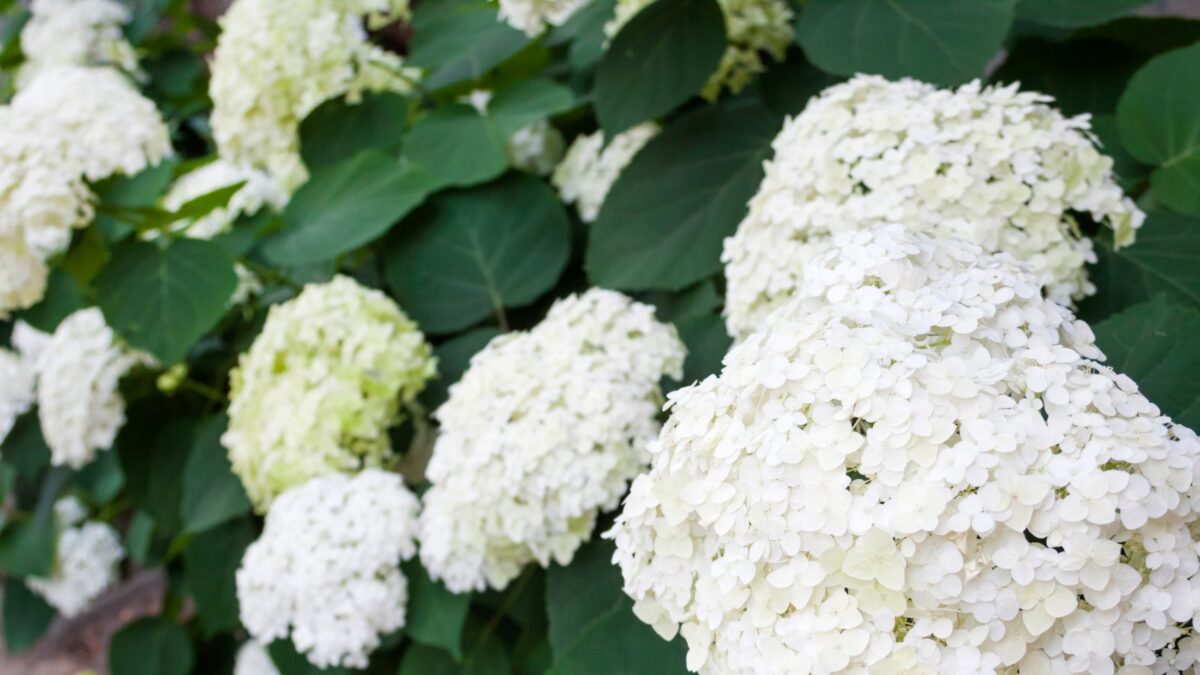If you’re looking for the perfect hydrangea for your garden, Annabelle might be it. A favorite among gardeners, Annabelle hydrangea flowers are stunning and remarkably easy to grow. Learn more in the guide below, from a physical description to care and troubleshooting tips.

All About Annabelle Hydrangea Flowers
Annabelle is a cultivar of smooth hydrangea (Hydrangea arborescens), a species native to the eastern US. In 1910, Harriet Kirkpatrick noticed an especially showy hydrangea while horseback riding in the woods near her hometown of Anna in southern Illinois. She and her sister-in-law, Amy Kirkpatrick, transplanted the shrub in her yard. The name, coined in 1962 when Annabelle hydrangeas were first released for commercial production, is a nod to the town of Anna and the two “belles” who discovered the cultivar.
Although the first Annabelle hydrangea recorded was found growing in the wild, it had mutated to express genes for showier flowers, increasing ornamental appeal while decreasing biological value. The larger, showier flowers of hydrangeas are actually sterile, while the smaller, less conspicuous blossoms hold value for pollinating insects. So while Annabelle hydrangea is a native cultivar, or “nativar,” it holds little wildlife value with its large, sterile blooms.
Annabelle is an excellent choice if you want a stunning hydrangea for your garden! Just make sure to plant some other native flowers to support the pollinators.
Annabelle hydrangea colors

Annabelle hydrangea flowers initially bloom lime green, brighten to a brilliant white, then turn pale green again. In fall, they dry to a tan shade, providing winter interest.
The huge, rounded flower clusters reach eight to 12 inches across. They start blooming in June, continue for about two months before fading, and sometimes produce a small repeat bloom in the fall.
If you love white flowers, add some of these to your landscape:
Annabelle hydrangea size
Like the rest of its species, Annabelle hydrangea typically grows about three to five feet tall and four to six feet wide. It has a rounded habit and dark green, serrated leaves that turn yellow in the fall.
Annabelle hydrangea care
A low-maintenance perennial shrub, Annabelle hydrangea is fairly easy to please. It prefers average, evenly moist, well-draining soil.
While Annabelle hydrangeas tend to do best in light shade, they can also thrive in full sun if provided with plenty of water, especially in regions where summers aren’t hot. Well-established plants require little to no supplemental water.
How to prune Annabelle hydrangea
Annabelle hydrangeas do not require pruning, but you will get the best blooms if you give the shrubs a little extra attention once a year. Because the flowers bloom on new wood, pruning the plants back almost to the ground will result in more vigorous growth and better form.
The best time to prune Annabelle hydrangeas is in late winter.
If you choose not to do a hard late-winter prune, clear away any dead or damaged stems in early spring, to make room for new growth and blooms.
Annabelle hydrangea problems
Being such an easygoing plant, Annabelle Hydrangea rarely suffers from pests or diseases. If you notice pests munching on your shrub — likely aphids, mites, or scale — thoroughly spray the leaves with an organic insecticidal soap on a windless evening. Make sure to follow the instructions on the label carefully.
Root rot is the most common disease among Annabelle hydrangeas, though if you plant your hydrangea in well-draining soil and not over-water it, you shouldn’t have problems with this.
If you do notice signs of root rot, try these:
- improve air circulation around the plant
- reduce watering
- consider transplanting it to a location with better drainage
Watch also for the less common botrytis fungus, a fluffy gray mold on flowers and foliage, and mushroom root rot, characterized by golden mushrooms at the base of the shrub.
Annual pruning and good air circulation help prevent these diseases. If you see them on your plant, remove any diseased stems and dead leaves as soon as you notice them.
More Beautiful Hydrangeas With Spectacular Blooms
- Endless Summer Hydrangea (Hydrangea macrophylla Endless Summer)
- Limelight Hydrangea (Hydrangea paniculata Limelight)
- Nikko Blue Hydrangea (Hydrangea macrophylla Nikko Blue)
- Pinky Winky Hydrangea (Hydrangea paniculata Pinky Winky)
- Twist-n-Shout Hydrangea (Hydrangea macrophylla Twist-n-Shout)
- Tardiva Hydrangea (Hydrangea paniculata Tardiva)
- Snowball Hydrangea (Hydrangea arborescens Snowball)
- Bluebird Hydrangea (Hydrangea macrophylla Bluebird)
- Incrediball Hydrangea (Hydrangea arborescens Incrediball)
If you love hydrangeas and have some around your property, here are some guides that will help:
- how to use hydrangeas in your front yard landscape
- what to plant with hydrangeas
- tips for pruning hydrangea plants
- what to do if your hydrangeas aren’t blooming
- here’s some help if deer are eating your hydrangeas
FAQs about Annabelle hydrangeas
Still have questions about Annabelle hydrangeas? We have some answers! Here are some commonly asked questions about Annabelle hydrangea flowers.
Is Annabelle hydrangea deer resistant?
Unfortunately, Annabelle hydrangeas are not deer resistant. To the contrary, Rutgers gives smooth hydrangeas a C rating for deer resistance (on a scale of A to D), meaning they are “occasionally severely damaged” by deer.
So if your yard is frequented by deer, hydrangeas may not be the best shrub for your landscape. You can, however, try to successfully grow hydrangeas by using a physical barrier, such as fencing or netting, or by spraying organic deer repellent on the plant when buds begin forming.
Another option is planting hydrangeas closest to your house and planting only deer-resistant plants further out, to try to mask the hydrangeas from the deer. (Here’s more on how to stop deer from eating hydrangeas.)
Does Annabelle hydrangea grow in the shade?
Yes, Annabelle hydrangeas actually grow best in dappled shade, especially where summers can get especially hot and dry. However, too much shade might result in fewer, smaller flower clusters. Dappled or afternoon shade is ideal.
Do Annabelle hydrangeas need fertilizer?
When grown in ideal conditions, Annabelle hydrangeas need little to no fertilizer. As noted above, this means average, evenly moist, well-draining soils and light shade. Annabelle hydrangeas in poor soil or full sun will need more fertilizer than those in rich soil and low light.
When necessary, apply a slow-release fertilizer just before the plants flower or leaf out. Fertilizer with a higher potassium level (the second number in the NPK ratio) is ideal, though a balanced NPK ratio also works. You don’t need acidic fertilizer with Annabelles, which have naturally brilliant-white blooms, and take care not to overfertilize, which will result in leggy plants.
Is Annabelle hydrangea toxic?
Annabelle hydrangeas are mildly poisonous to humans, causing stomach upset if ingested. They are also toxic to cats, dogs, and horses.
Annabelle hydrangeas are among the most popular hydrangea cultivars for a reason. These easygoing shrubs have few requirements and rarely suffer from pests or diseases, and their large, showy flower clusters are hard to resist. If you’re looking for a hydrangea for your garden, this might be it!





The 6 Most Popular Types Of Hydrangeas To Choose For Your Garden
Thursday 22nd of June 2023
[…] called wild hydrangea, smooth hydrangea is native to the eastern US. This widely branched shrub grows up to six feet tall, making it an […]
8 Tips For Landscaping With Hydrangeas In Any Garden
Thursday 22nd of June 2023
[…] They can even be planted in a hedge to enclose a space and add privacy with elegance and beauty. Annabelle hydrangea flowers are great for this […]
How To Prune Hydrangeas For Gorgeous Summer Flowers
Thursday 22nd of June 2023
[…] Smooth Annabelle hydrangea (H. arborescens and cvs., Z 4–9) […]